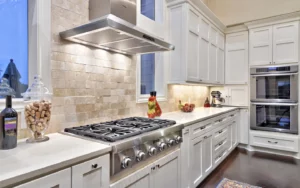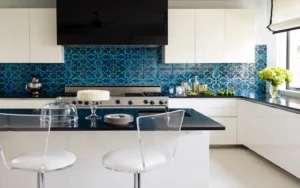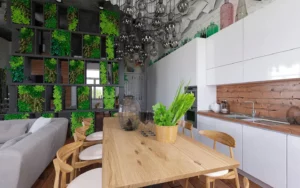Kitchen tiles show a detailed picture of history, practical use, and beautiful looks. When you walk into a kitchen, the tiles catch your eye first. It might be the carefully made backsplash behind the stove or the tough floor that’s seen many cooking moments; tiles make their mark. They have two jobs: protecting and giving homeowners a big area to show their design tastes. From old-timey details to the clean looks of modern designs, kitchen tiles have changed a lot, reflecting changes in building styles, art tastes, and new tech.
Read more about Kitchen Decoration
Understanding the Changes in Kitchen Tile Styles
With their link to history, kitchen tiles tell a deep, fascinating story. Old Roman cooking places had detailed mosaics that showed daily life, turning an everyday place into art. Looking to the east, the colorful tiles of Persia told stories full of grandeur. The Renaissance period in Europe saw the rise of handmade painted tiles, showing the big cultural changes of the time. When the 20th century began, the Art Deco style brought bold patterns and shapes. Now, while tech lets us copy any old design, there’s a big move towards eco-friendly materials. At this crossroad, mixing respect for history with new ideas gives homeowners many options.

Modern Kitchen Tile Design
Today’s kitchen is about style and usefulness, and modern tile designs play a big role. Simple designs are popular, but sometimes there are surprising twists. Many people like neutral colors, but now and then, bright, fun colors make things interesting. Tile shapes have also changed, with classic rectangles replaced by shapes like hexagons. Different surface feels, from smooth to shiny, are everywhere. The big story of helping the environment means tiles made from reused stuff, adding more history. Whether it’s a new take on the old terrazzo or the cool look of bio-glass, today’s kitchen tile shows creativity, skill, and eco-care.

Choosing Between Ceramic and Porcelain
There’s a big question among kitchen tiles: pick ceramic or porcelain. Both come from simple clay but have their special places. Ceramic tiles, made by heating clay, are loved for their simple beauty, low cost, and ease of working, making them popular for DIY projects. But they need a strong top coat to handle water, especially in kitchens where things might spill.
Porcelain tiles are made from better clay and are heated more. This process makes a harder tile, lasts longer and doesn’t get wet or stained easily. They’re the top choice for busy kitchen floors. Even though they cost more and are harder to cut than ceramic ones, they last a long time. When picking between ceramic and porcelain, don’t just go by looks. Think about use, strength, and cost.
Picking the Right Tile Color for the Kitchen
The color of your kitchen tiles does more than a match with counters and cabinets; it sets the whole mood. Light whites and soft colors can make a small kitchen feel bigger, reflecting light and giving a clean, open feel. On the other hand, dark colors, like deep blue or black, can make a place feel fancy but cozier, maybe needing more lights.
Beyond basic colors, there are many tile colors to pick from. Warm, brown terracottas remind you of country places, while bright blues or greens can make you think of sunny beach places. A new trend, where tiles change from one color to another, adds motion and a fresh look. It’s key to understand how colors feel, making sure they fit the kitchen’s vibe.
Patterns and Looks: Simple Ways to Show
Colors might be the first thing you notice, but the designs and feels of kitchen tiles tell a story, adding layers of style. The classic subway tile, always loved, has seen fun changes in colors and placement. Designs like chevron and herringbone are returning, giving kitchens a cool, old-school look. And for the brave, Moroccan and shape-based designs can turn regular back areas into beautiful art.
There’s something else we need to talk about when it comes to the tile – its texture. Shiny tiles reflect light, making places bright and easy to clean—great for always-busy kitchens. On the other hand, dull tiles have a calm beauty, spreading light gently and looking down-to-earth. Tiles made by hand, with their little differences, make places feel unique and full of life. Looking at all these designs and feels, tiles can be the background and main focus, wanting to be a part of your kitchen’s story.
Leaen more aboute: Smart Kitchen
Eco-Friendly Tiles: Loving the Planet
As people change, being eco-friendly is not just a cool topic—it’s a real promise, and kitchen tiles are joining in. Both homeowners and designers are choosing tiles that are good for the Earth. This move is not just about being green but also about bringing nature into homes. Tiles made from recycled materials, like glass and old tiles, are becoming popular. These tiles’ unique feel and colors tell stories of new starts and strong spirits.

Old tiles, saved from ancient houses or famous places, have the spirit of old times and a forever beauty. More than the material, how tiles are made is also turning green. Companies use less water and energy-saving machines, making tiles in a way that’s better for the Earth. Picking green tiles shows love for the planet and tells others about a homeowner’s beliefs and style.
The Story of Grout: The Unsung Hero
Tiles get all the attention, but grout, their silent partner, is super important for how the tile area looks and lasts. Its main job is to hold tiles and keep water out, but the grout’s color and feel can change the tiles’ look. Grout colors that stand out can highlight each tile, showing off its design. Grout that matches creates a smooth look.
There’s more to grout than color. There’s rough grout and smooth grout. Rough grout is good for big spaces between tiles, holding tight and not getting smaller. Smooth grout is best for small gaps and soft tiles like glass, ensuring they are not scratched. Thanks to new tech, we have new grouts that don’t let water in, resist stains, and last long. In the big world of tiles, while tiles are the main stars, grout holds everything together, ensuring long-lasting beauty and skill.
Blending Tradition with Trend: The Fusion Aesthetic
In the vibrant realm of kitchen tiles, a fresh perspective is emerging: the fusion aesthetic. This approach isn’t about choosing between traditional designs’ timeless charm and contemporary patterns’ edgy allure. Instead, it celebrates the harmonious blending of both.
Tiles that carry the markings of age-old craftsmanship now sit beautifully beside those boasting sleek, modern finishes. Imagine a kitchen where terracotta tiles, reminiscent of ancient marketplaces, meet the metallic sheen of modern geometric patterns. Such a blend gives rise to spaces rooted in history and forward-thinking in design.
Ending Thoughts: Creating Your Kitchen’s Heart
Kitchen tiles shine brightly in home design, telling old stories and hinting at the future. Every tile has history, beauty, and promise. The kitchen deserves this mix of design, skill, and new ideas. Choosing tiles is not just about picking patterns or colors; it’s like creating memories and tales. It’s a mix of dreams, practical needs, and personal touch. So, if you’re thinking of changing things up or just daydreaming, let the wide world of kitchen tiles spark your creativity, helping you create places that reflect, match, and celebrate.
KEYWORDS:
